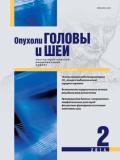CONTEMPORARY APPROACHES TO LEVOTHYROXINE THERAPY AFTER SURGERY IN PATIENTS WITH WELL-DIFFERENTIATED THYROID CANCER
- Authors: Rumyantsev P.O.1, Korenev S.V.2, Rumyantseva U.V.1
-
Affiliations:
- Endocrinology Research Center, Moscow
- Medical institute, Immanuel Kant Baltic Federal University, Kaliningrad
- Issue: Vol 3, No 2 (2013)
- Pages: 5-8
- Section: DIAGNOSIS AND TREATMENT OF HEAD AND NECK TUMORS
- Published: 15.04.2013
- URL: https://ogsh.abvpress.ru/jour/article/view/3
- DOI: https://doi.org/10.17650/2222-1468-2013-0-2-5-8
- ID: 3
Cite item
Full Text
Abstract
Levothyroxine therapy with purpose to suppress thyroid stimulating hormone (TSH) after surgery in patients with well-differentiated thyroid cancer is implemented since 1937. Accumulated results of levothyroxine suppressive therapy (LST) application are attesting its heterogeneous efficacy in various risk groups of tumor recurrence: low, medium and high. Similar risk groups are emphasized towards adverse effect risk due to LST. The more intensivity and duration of TSH suppression the higher risk of adverse effects. First, they include osteopenia or osteoporosis and atrial fibrillation. Contemporary approaches to intensivity and duration of LTS are based on accounting of its potential efficiency into various clinical risk groups of tumor recurrence as well as adverse effects risk groups.
About the authors
P. O. Rumyantsev
Endocrinology Research Center, Moscow
Author for correspondence.
Email: rumyantsev.pavel@endocrincentr.ru
Russian Federation
S. V. Korenev
Medical institute, Immanuel Kant Baltic Federal University, Kaliningrad
Email: fake@neicon.ru
Russian Federation
U. V. Rumyantseva
Endocrinology Research Center, Moscow
Email: fake@neicon.ru
Russian Federation
References
Supplementary files







